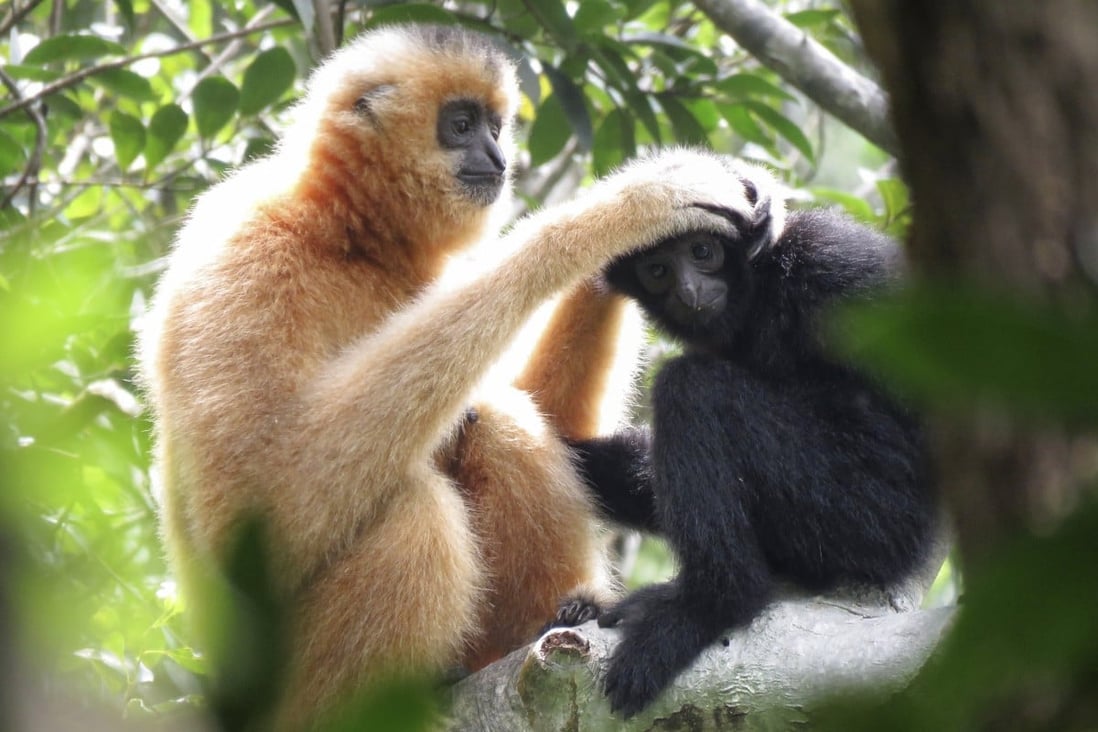The Hainan gibbon is the most endangered of all gibbons and the world’s rarest primate.
It is endemic to the southern Chinese island of Hainan. Its population has increased from as few as 7 to 9 in the 1980s to 35 today, according to a report released at the WCC held both online and in-person in Marseille, France.
The conservation of Hainan gibbons in China is a success for biodiversity preservation worldwide, the International Union for Conservation of Nature (IUCN) announced on September 5 during the ongoing 7th World Conservation Congress (WCC).

The report, titled “The Hainan Gibbon Case Study: Effectively Saving a Critically Endangered Species” and written by 15 experts from 11 organizations worldwide, was released at a press conference simultaneously held in Marseille and Haikou, capital of China’s Hainan Province.
The success of this case was achieved “thanks to efficient protection by the Chinese central to local governments and a combined effort by Chinese and international scientists and conservation communities to understand the behavioural ecology of these gibbons,” Susan Cheyne, a specialist on small apes with the IUCN Species Survival Commission (SSC), told the press via video link.
Dubbed as “Giant Panda of Hainan,” Hainan gibbon is currently found only in a single reserve, the Bawangling Nature Reserve, part of the Hainan Tropical Rainforest National Park.
The Hainan crested gibbon (Nomascus hainanus) exhibits sexual dichromatism which means that the males and females of this species have different colored fur coats on their bodies. While the male Hainan gibbon has a black coat with white-colored cheeks and crown, the female is golden or buff in color and has black-colored cheeks and crown.
“China nature conservation is a modern-day global example of how you have to go about conservation.”
In March, the monitoring team found that two of the Hainan Gibbon groups each added a baby ape, 7 months old and 6 months old, respectively, said Huang Jincheng, director of the Forestry Department of Hainan Province, at the press conference.

“Continuous monitoring showed that the two baby apes are in good health and grow well,” said Huang. “So far, the population of Hainan gibbons has recovered to 5 groups with a total of 35 individuals.”
“Hainan gibbon is a very important example of how we can have a conservation success even when a species gets down to a very low level,” said Russell Mittermeier, chairman of the IUCN-SSC Primate Specialist Group.
The experiences of this case should be applied to other members of this endangered genres, he added.
Vance Martin, president of the U.S.-based WILD Foundation, told Xinhua after the conference that the case of the Hainan Gibbon is very special because of its extremely low number.
The reason behind this successful conservation is “brilliant and enlightened leadership, international cooperation and experts who really care, and then it is the unique way that the leadership enlisted the local community and the local community who wanted to do it,” he said.
Martin, also an expert in international nature conservation and wilderness protection, said there is a big picture story going on in China with nature conservation, “which is a modern-day global example of how you have to go about conservation.”
“China’s example with eco-civilization, and looking at big picture and putting the big picture to work locally in particular areas with community involvement, is exactly what the world needs to do,” he concluded.
Source: Beijing Review, 2021-09-07 http://www.bjreview.com.cn/Latest_Headlines/202109/t20210906_800257472.html
About Hainan Tropical Rainforest National Park
Hainan tropical rainforest is located in the northern edge of the tropics. It is the continental island type of tropical rainforest with the most concentrated distribution, the best preservation and the largest contiguous area in China.
China central government launched the project of constructing Hainan Tropical Rainforest National Park System Pilot Area. The construction of Hainan Tropical Rainforest National Park System Pilot Area is regarded as an important part of the construction of National Ecological Civilization Experimental Area.
The linked research paper explored and analyzed the path to and experiences of constructing Hainan Tropical Rainforest National Park System Pilot Area from the aspects of management system, ecological protection and restoration, natural resources asset management, community involvement, exchange and education.
It has found that Hainan Tropical Rainforest National Park System Pilot Area has established a unified and coordinated management system by integrating and optimizing the existing nature reserves. It implements strict protection system, and carries out ecological protection and restoration, confirmation of natural resources rights, construction of community development, and establishment of science popularization and education system.
The unified and coordinated management has provided a guarantee for biodiversity of major species in Hainan Province. Hainan Tropical Rainforest National Park System Pilot Area can provide valuable experiences for China National Park System Pilot Project.

Read more: on the Hainan Tropical Rainforest National Park at the following article – https://www.sciencedirect.com/science/article/pii/S2577444120300502
One of 10 national parks that China plans to create is the Hainan Tropical Rainforest National . The new Hainan’s park will link existing reserves in the central region of the island to form an approximate 4,400-square-kilometer protected area. Its “flagship species” is the Hainan gibbon (Nomascus hainanus).